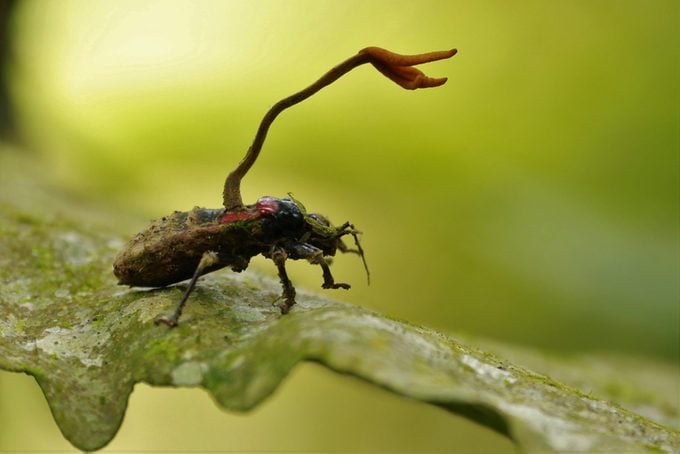Is ‘The Last of Us’ Fungus Real?
Updated: Feb. 07, 2023

Let's separate fungal fact from fungal fiction.
At the center of the television zeitgeist these days is HBO’s The Last of Us, a video game adaptation about a fungus that turns humans into zombies. Funnily enough, the show’s creators based the fungus on a real-life species that has some remarkable effects. For the curious among us, here’s everything to know about the fungus that inspired the hit drama.
What fungus is The Last of Us based on?
The fungus in The Last of Us is based on Ophiocordyceps unilateratis, aptly nicknamed the “zombie-ant fungus” or just cordyceps. This powerful parasite infects insects, such as ants or spiders, and drains its host’s body of nutrients before replacing them with spores in order to reproduce. Now here’s the interesting part: the fungus can perform a sort of “mind control” on the bug, compelling it to climb to higher levels and wait there until it expels the spores, thus spreading the infection as widely as possible. Creepy!
How does cordyceps perform mind control?

Interestingly enough, scientists are not yet fully sure how cordyceps and other fungi like it perform this function. According to Bryn Dentinger, a biology professor at the University of Utah and curator of mycology at the Natural History Museum of Utah, it likely involves a combination of muscular and chemical processes: “There seems to be some combination of physical manipulation of muscle fibers, for example, possibly growth into the brain itself, that can impact [the host’s] behavior…But there’s also very likely some sort of chemical attack on the host, either small molecules, or proteins or some other things, that end up manipulating brain behavior.”
Can cordyceps infect humans in real life?
Fortunately for us, cordyceps cannot infect humans. Detninger explains that “[o]ur body temperatures are high enough so that most organisms, their proteins would denature at that temperature and so they can’t survive in our bodies.”
Could there eventually be a mind-controlling fungus that can infect humans?
A more temperature-resistant mind-controlling fungus is not totally out of the question, says Detninger. At this time, none exist, though climate change is forcing more fungus species to adapt to higher temperatures, which “may be why we’re seeing more fungal infections in humans.” It’s also worth noting that we’re already familiar with some fungi that can alter the mental state of humans, namely, psilocybin, or magic mushrooms.
However, it is highly unlikely that a mind-controlling fungus afflicting insects could jump over to afflict humans. According to Detninger, such fungi are highly specialized to their prey, and “we’re so different” from ants that those specializations aren’t really transferrable.
How else did real-life science inspire the The Last of Us?
On the HBO show, the fungus connected infected hosts through a communicative network. While this is also not accurate to real-life cordyceps, it was likely inspired by some amazingly complex features of fungi. For years, scientists have known that fungi can send electrical impulses to each other through their underground root network, called a mycelium. But just last year, a study published in Royal Society Open Science demonstrated that the electrical impulses in four fungi species resemble a human vocabulary of about 50 words. Split gill mushrooms, in particular, could supposedly form “remarkably diverse” sentences.
Some mycologists are skeptical about the study’s comparison of fungi’s impulses to human languages. Dan Bebber of the University of Exeter explains, “the interpretation as language seems somewhat overenthusiastic, and would require far more research and testing of critical hypotheses before we see ‘Fungus’ on Google Translate.” While that may be the case, one thing is for sure: scientific speculation makes for ridiculously compelling TV. Real life—it really is stranger than fiction.
Sources:





















